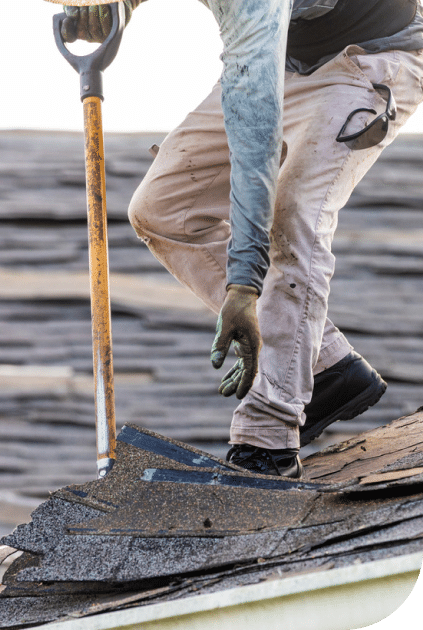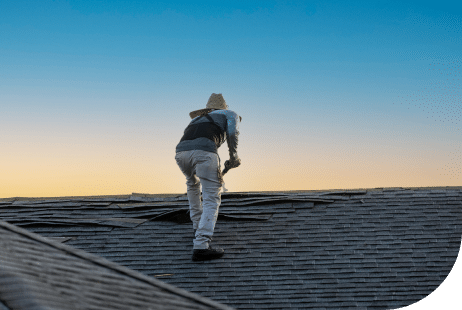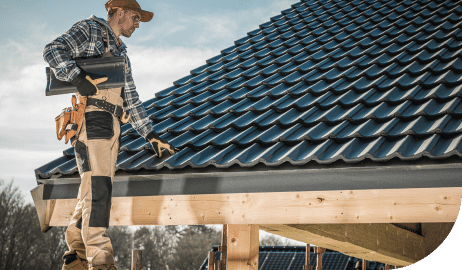Asbestos in Roof Shingles
Asbestos shingles became an industry standard as early as the 1920s due to their fire resistance and durability. Unfortunately, the asbestos fibers within the shingles had the potential to cause deadly diseases. The public only became aware of this after the toxic shingles were installed on hundreds of thousands of roofs throughout the country. The deadly effects are still being felt today.
Home » National Mesothelioma Law Firm » Asbestos Exposure » Asbestos in Consumer Products and Materials » Asbestos in Roof Shingles
What Are Asbestos Roof Shingles?
Companies That Manufactured and Supplied Asbestos Shingles
Do Other Roofing Materials Contain Asbestos?
How Are People Exposed to Asbestos Through Roofing Shingles?
Is Asbestos Still Used for Roofing?
Occupations That May Have Experienced Asbestos Exposure Through Roof Tiles
How Can I Tell Whether I Have Asbestos Roof Shingles?
What Should I Do if I Have Asbestos Shingles on My Roof?
Asbestos has been revered for its fire resistance and indestructibility since ancient times. Its flexibility made it easy to mix into other materials, and its tensile strength was useful for reinforcing products like cement. It was abundant and inexpensive, making it ideal for the mass production of asbestos roofing shingles.
Unfortunately, asbestos exposure causes deadly illnesses later in life, including mesothelioma, lung cancer, and asbestosis. Asbestos roof tile can release harmful fibers when it becomes damaged or worn, resulting in significant exposure, especially for workers who are exposed to them daily over an extended period.
What Are Asbestos Roof Shingles?
Asbestos roof shingles may be comprised of asphalt or cement, with asphalt asbestos shingles being more common, according to Burns Environmental Services. They were manufactured and supplied from 1920 until 1986.
Asphalt Shingles
Houses that caught fire during the early 1900s were basically tinderboxes that would quickly burn, often resulting in nearby housing burning down as well. The fire resistance of asbestos shingles made them appealing to builders and homeowners.
Asphalt asbestos shingles were the most likely to contain asbestos, and they were used on the majority of homes and buildings. Roofing manufacturers made them even more appealing by adding pigment so they were available in colors other than gray.
Cement Asbestos Shingles
Cement asbestos shingles were less common than asphalt shingles. They were most often used for outdoor structures and low-income housing.
Transite Roofing Panels
Corrugated asbestos cement roofing sheets, also known as transite roofing panels, were often used on commercial and industrial buildings that created harsh conditions, such as high heat, chemical emissions, and humidity. This included the following:
- Foundries
- Forges
- Chemical plants
- Paper plants
- Wastewater treatment plants
- Sewage facilities
The Transite brand of asbestos cement was originally patented by Johns Manville and used in a variety of applications. Eventually, all asbestos cement was referred to as transite, similar to how all facial tissue is referred to as Kleenex.

Companies That Manufactured and Supplied Asbestos Shingles
The following asbestos companies manufactured or supplied asbestos roofing shingles:
- Asbestos Corrugated Sheathing
- Asbestos Shingle, Slate and Sheathing Company
- Atlantic Asphalt and Asbestos Corporation
- Barrett Roofing
- Certainteed Corporation/Saint Gobain Corporation
- Eternit Corporation
- Flintkote Corporation
- GAF Corporation
- Johns Manville
- National Gypsum Company
- Reynolds Metals Corporation
- The Keasbey and Mattison Company
Do Other Roofing Materials Contain Asbestos?
Roofing shingles are not the only roofing material that may contain asbestos. Asbestos was also used in the following:
- Roofing felt
- Tar
- Adhesives
- Asphalt tar paper
- Corrugated cement panels
- Slate tiles
- Caulking
- Mastic
- Sealant
- Roof flashings
- Roof flat sheets
It was also present in structures that may have been accessible on the roof, such as chimney brick and mortar, chimney flues, stove flues, and plumbing vents.
How Are People Exposed to Asbestos Through Roofing Shingles?
Asbestos exposure occurs when the microscopic fibers are disturbed and become airborne. Airborne asbestos may be inhaled or ingested. Asbestos fibers in roofing materials are considered non-friable, which means they are encased in a hardened material where they cannot be disturbed by hand pressure alone.
However, asbestos in roof shingles may be disturbed when the asbestos roof tiles wear down over time. It can also be disturbed if the tiles are crushed, broken or otherwise damaged. This can occur during the following activities:
- Roof repairs
- Removal of the asbestos shingles
- Cutting of the shingles
- Drilling or puncturing of the shingles
- Demolitions
- House fires
In the event of a house fire, as the shingles are destroyed, significant quantities of asbestos fibers can be released over a large area. Asbestos in products like roofing felt and adhesives may also be disturbed at the same time asbestos shingles are damaged.
Is Asbestos Still Used for Roofing?
Many uses of asbestos have been banned, but this does not apply to all roofing materials. Asbestos asphalt roofing compounds are still in use today, including coatings, cement, and mastics, according to Inspectapedia.
The asbestos in these products can be disturbed while working with roof shingles, whether or not the shingles themselves contain asbestos. Fortunately, the use of asbestos-containing roofing materials today is limited to commercial construction.

Occupations That May Have Experienced Asbestos Exposure Through Roof Tiles
The greater the frequency, the heavier the exposure, and the longer the duration of occupational asbestos exposure, the greater the risks to health. However, a single exposure to asbestos is all it takes for some workers to develop mesothelioma.
Factory workers involved in the production of asbestos roof shingles would have experienced high levels of exposure. The workers listed below still face asbestos exposure when working with roofing shingles today.
Construction Workers
The following construction workers may be exposed to asbestos in roof shingles:
- Roofers
- Builders
- Carpenters
- Remodelers
- Demolition workers
- Sheet metal workers
Service and Repair Workers
The following workers may also be exposed to asbestos roof shingles:
- Firefighters
- Laborers
- Military personnel
When a building catches fire and the roof is damaged, firefighters and bystanders may be exposed to asbestos, which will generally not be destroyed by the fire. Instead, it will be released into the air over a large area in an uncontrolled manner.

How Can I Tell Whether I Have Asbestos Roof Shingles?
There are no visual identifiers that can definitively confirm or eliminate the presence of asbestos in roofing shingles. Professional testing is the only way to know for sure. You should never climb onto the roof and try to determine this for yourself. If any of your roof tiles are worn or otherwise damaged, merely walking on them could stir up asbestos.
What Should I Do if I Have Asbestos Shingles on My Roof?
If testing confirms the presence of asbestos in your shingles, an asbestos abatement company can determine the safest abatement method for your situation. In some cases, the safest option may be to leave the roof in place and cover it with a second roof.
Removal of asbestos-laden materials may be an option, but this process will be significantly more expensive and require more time. A licensed contractor will need to perform this work. You should not try to do it yourself. Any slight error could result in asbestos fibers being disbursed over a wide area, impacting multiple people.
How Dangerous Is Asbestos in Roof Shingles?
Although being exposed to asbestos outdoors may result in lower exposure levels than in poorly ventilated, closed-in spaces, studies show that the degree of exposure is sufficient to result in asbestos-related diseases.
According to a study published by the Journal of Surgical Case Reports, roofing is a high-risk occupation for peritoneal mesothelioma, an aggressive cancer of the lining around the stomach.
An Italian study published by Environmental Health also found that roofing is a high-risk occupation for lung cancer and pleural mesothelioma. Pleural mesothelioma is an aggressive cancer of the lining surrounding the lungs with a life expectancy of fewer than two years with treatment.
Our mesothelioma law firm treats clients like family, fighting skillfully and passionately to recover maximum compensation. We have more than 30 years of experience helping asbestos exposure victims get justice with a successful track record of consistently achieving historic verdicts and settlements.
Do I Need a Lawyer?
Without the help of an experienced mesothelioma lawyer, you could miss out on significant financial compensation for asbestos exposure. While compensation will not undo a mesothelioma diagnosis, it can improve your access to medical care and provide financial security for you and your family.
Asbestos manufacturers are large companies with significant financial resources. They hire lawyers, and you should too. Our experienced asbestos exposure lawyers understand the toll a mesothelioma diagnosis can take on an individual and a family.

Contact The Lanier Law Firm Today
If you have been diagnosed with an asbestos-related illness, you may be entitled to substantial compensation. Contact a mesothelioma lawyer today for a free case evaluation.
By submitting this form, you agree to our terms & conditions. Please read the full disclaimer



